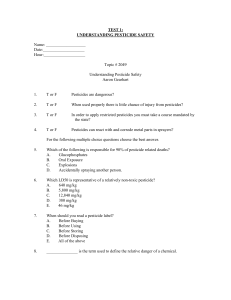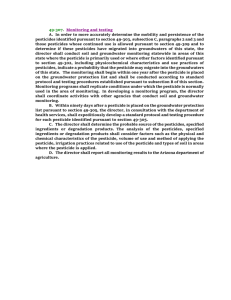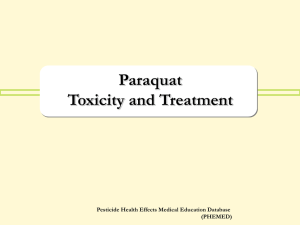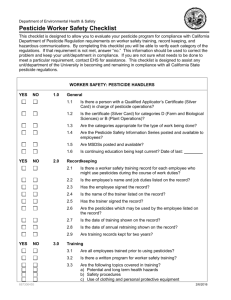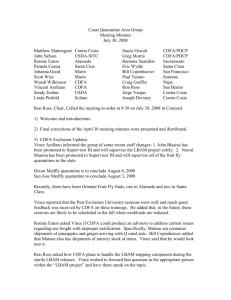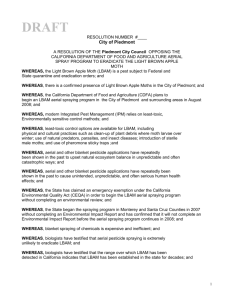Dr. Larry Rose statement
advertisement
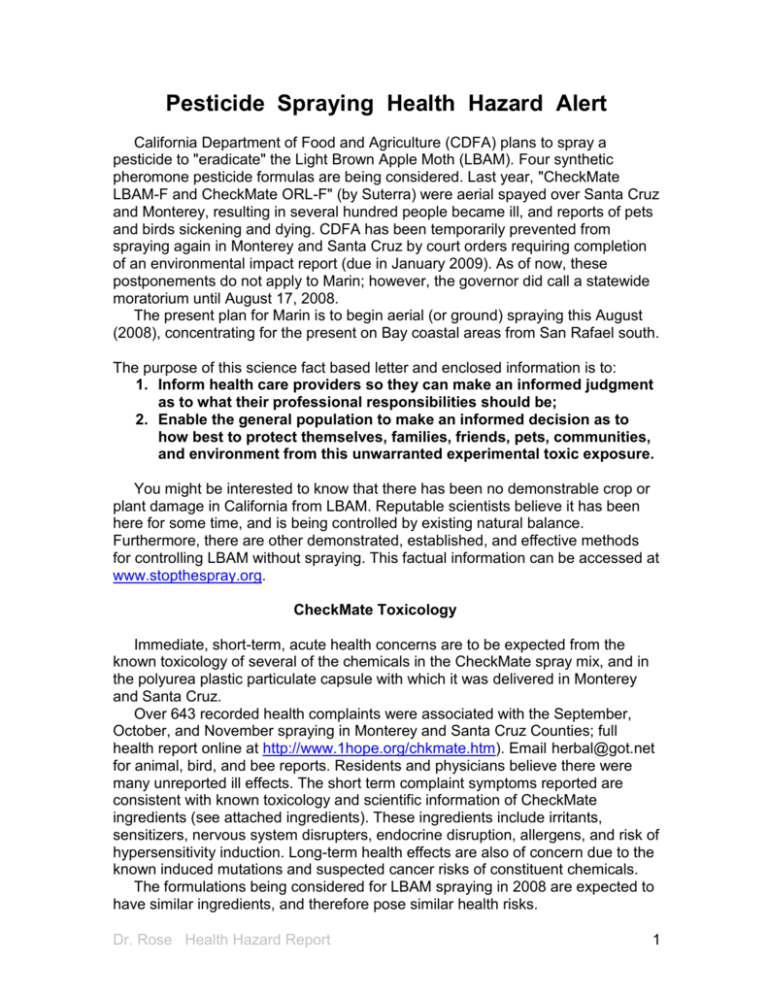
Pesticide Spraying Health Hazard Alert California Department of Food and Agriculture (CDFA) plans to spray a pesticide to "eradicate" the Light Brown Apple Moth (LBAM). Four synthetic pheromone pesticide formulas are being considered. Last year, "CheckMate LBAM-F and CheckMate ORL-F" (by Suterra) were aerial spayed over Santa Cruz and Monterey, resulting in several hundred people became ill, and reports of pets and birds sickening and dying. CDFA has been temporarily prevented from spraying again in Monterey and Santa Cruz by court orders requiring completion of an environmental impact report (due in January 2009). As of now, these postponements do not apply to Marin; however, the governor did call a statewide moratorium until August 17, 2008. The present plan for Marin is to begin aerial (or ground) spraying this August (2008), concentrating for the present on Bay coastal areas from San Rafael south. The purpose of this science fact based letter and enclosed information is to: 1. Inform health care providers so they can make an informed judgment as to what their professional responsibilities should be; 2. Enable the general population to make an informed decision as to how best to protect themselves, families, friends, pets, communities, and environment from this unwarranted experimental toxic exposure. You might be interested to know that there has been no demonstrable crop or plant damage in California from LBAM. Reputable scientists believe it has been here for some time, and is being controlled by existing natural balance. Furthermore, there are other demonstrated, established, and effective methods for controlling LBAM without spraying. This factual information can be accessed at www.stopthespray.org. CheckMate Toxicology Immediate, short-term, acute health concerns are to be expected from the known toxicology of several of the chemicals in the CheckMate spray mix, and in the polyurea plastic particulate capsule with which it was delivered in Monterey and Santa Cruz. Over 643 recorded health complaints were associated with the September, October, and November spraying in Monterey and Santa Cruz Counties; full health report online at http://www.1hope.org/chkmate.htm). Email herbal@got.net for animal, bird, and bee reports. Residents and physicians believe there were many unreported ill effects. The short term complaint symptoms reported are consistent with known toxicology and scientific information of CheckMate ingredients (see attached ingredients). These ingredients include irritants, sensitizers, nervous system disrupters, endocrine disruption, allergens, and risk of hypersensitivity induction. Long-term health effects are also of concern due to the known induced mutations and suspected cancer risks of constituent chemicals. The formulations being considered for LBAM spraying in 2008 are expected to have similar ingredients, and therefore pose similar health risks. Dr. Rose Health Hazard Report 1 It is also important to consider the risks of the polyurea plastic capsules. Industrial production of this plastic uses isocyanate catalysts that can cause serious acute reactive bronchial constriction (asthma attacks) in exposed worker populations. Glaring deficiencies in the animal toxicology studies of the spray are extremely important. There were no inhalation studies, though some simple ones are apparently planned. There have been no long term or multigenerational health studies done on this brew of toxic chemicals. Population at Risk for Immediate Acute Reactions The panoply of symptoms that occurred in the 643 recorded Monterey and Santa Cruz complainants included: asthma attacks, bronchitis, productive pulmonary congestion, shortness of breath, wheezing, coughing, chest pain and tightness, nasal congestion, sore throats, eye irritation, blurred vision, severe skin rashes, sinus bleeding that reflected acute upper respiratory distress, and eye and dermal reactions. Cardiopulmonary reactions included arrhythmia and tachycardia. More generalized acute debilitating systemic reactions included headaches, trouble concentrating, dizziness, muscle aches, tremors, gastrointestinal pain, diarrhea, lethargy, malaise, and fatigue. There were frank hormonal disturbances as evidenced by breast symptoms and menstrual irregularities. Relevant medical histories, current medication, and most important, timing in relationship to the spraying, will give primary care practitioners the information needed to connect these patients to the pesticide exposure — if primary care practitioners receive and act on this information. Populations most at risk for acute reactions are asthmatics, infants, children, the elderly, patients with borderline cardiopulmonary compensation (e.g. chronic obstructive pulmonary disease, chronic bronchitis, pneumoconiosis, and marginal pulmonary vital capacity), congestive heart failure, cardiovascular abnormalities, angina, those with environmental illness, and medically debilitated patients. It is critical that patients with such medical profiles be protected from these lifethreatening (to them) airborne toxic ingredients. Long Term Health Risks Major toxicity concerns go beyond immediate acute effects when the known toxicology profiles of the ingredients (attached) include endocrine disruption, mutagens, suspected carcinogens, and immune system disruptors. Such exposures could well put the exposed population at increased risk for diseases later in life, e.g. hormone disruption (multi-generational), genetic damage, reproductive disorders (spontaneous abortions, infertility, low birth weight newborns, birth defects), developmental disorders, cancers and leukemia, neurological disorders, and immune system dysfunction. Many diseases that fit into these categories are increasing in frequency nationally, and are probably due mainly to toxic chemical environmental exposures. Testing of CheckMate thus far by the manufacturer and EPA is clearly Dr. Rose Health Hazard Report 2 inadequate to determine increased long term chronic health risks to the general population that would occur in these disease categories from airborne exposures. It is anticipated that testing on any other proposed pesticide will have the same deficiencies. Microcapsules Last year, the chemical cocktail was encased in a polyurea polymer microscopic plastic capsule reported to range in size from 10 to 190 microns. Recent research suggests that over half are 10 micron or less (PM10 and less). The micro capsules are designed to emit the synthetic pheromone over a 30 to 90 day period, requiring repeated applications. These airborne microscopic particles would drift and randomly disperse, according to the prevailing winds, to settle on all exposed life, houses, gardens, playgrounds, walkways, etc., and of course be inhaled by all breathing life forms including Homo sapiens. Any particle size under 10 microns is capable of reaching the finest lung bronchiolar air exchange units called alveoli. There has been no research to know how they will act if inhaled and break down in the lungs of humans, dogs, cats, etc. In order to avoid the intense criticism of the micro capsule delivery system, CDFA may use PVC chips/flakes (+/- 1/8 inch diameter) or a waxy formula. Whichever pesticide and delivery system are chosen, the strategy requires that the ambient air remain saturated with the pheromone for 9 months of the year, for 3-10 years. This experiment is unprecedented, unwarranted, and unnecessary. Discussion and Conclusion It has been six months since Monterey and Santa Cruz counties have been sprayed with CheckMate. The federal Department of Food and Agriculture, state CDFA, and state Department of Pesticide Regulation have not implemented or funded a well designed epidemiology study to determine scope and seriousness of the health impact on exposed residents in these two counties. This is far beyond irresponsible, and in fact criminal negligence would be a more appropriate label for the lack of public health follow-up. The longer these necessary public health follow-up studies are delayed, the more critical information will be lost. Health questionnaires administered to all residents could determine the scope and seriousness of all short term and later long term adverse health reactions. Exposed residents should expect nothing less. Any acute reactions or disabilities resulting in medical expenses, disabilities, or loss of income from these exposures should be totally compensated. Federal and state agencies responsible for this spraying decision must take financial and criminal responsibility for adverse impacts to health and environment. Physicians are legally required to report diagnosed pesticide related illness; but in the two sprayed counties there was no systematic notification that included probable short term health reactions sent to health providers, first responders, emergency rooms, or residents before the September, October, and November Dr. Rose Health Hazard Report 3 2007 sprayings. This is a shocking disregard of human rights in any democracy. Additional Information For more information about controlling LBAM without spraying the general population, visit www.stopthespraymarin.org or www.stopthespray.org. Most of the chemicals contaminating the nation’s population are through food, water, air, soil, and consumer products, such as household cleaners, construction materials, cosmetics, and pesticides. Many of these exposures cannot be measured in our bodies, but the cumulative contamination from some of this environmental contamination becomes part of our “body burden” and has public health implications. Furthermore, recent studies of hormone disrupting chemicals show health effects at extremely dilute (low) levels of exposure — down to parts per trillion in fetuses. For non-monotonic dose-response references, email healthhab@igc.org. More and more research is revealing that smaller and smaller amounts of substances have effects — some opposing and some quite profound, especially when involving endocrine disruption. For more on “Body Burden” studies access the following: 1. The CDC "Third Report on Human Exposure to Environmental Chemicals, 2005” (access through Goggle). 2. The recent Environmental Working Group study of toxic chemicals found in fetal cord blood. 3. A number of studies measuring toxic chemicals found in maternal milk. Author Information Lawrence Rose, M.D., M.P.H., was the senior Public Medical Officer for CalOSHA for 28 years, and in that capacity was for a time assigned liaison for CalOSHA to the statewide interagency pesticide advisory committee (recently retired), an Occupational/Environmental Medicine practitioner, and part of the UCSF Occupational/Environmental Medicine Department. CheckMate/ LBAM-F Partial Ingredients Information (E)-11-Tetradecen-1-yl Acetate Synthetic Pheromone component (E,E) -9,11 Tetradecadien-1-yl Acetate, Crosslinked polyurea polymer Synthetic Pheromone component and plastic encasement Z isomer? The Z-isomer is a “behavioral antagonist” (Karg et al. 1997. J Insect Physiol 43(2):179-187, q.v., citing Rumbo et al 1993 J. Chem. Ecol.19: 953-961) It is also one of the components released from pheromone dispensers, (Karg et al. 1997, op.cit., citing Suckling et al 1994. J Econ Entomol 87:1477-1487). Butylated Hydroxytoluene, =2,6-Di-tert-Butyl-p-Cresol [128-37-0] Dr. Rose Health Hazard Report 4 Other Synonyms: 2,6-Bis(1,1-dimethylethyl)-4-methylphenol; 2,6-Di-tert-Butyl-1Hydroxy-4-Methylbenzene; 2,6-Di-tert-Butyl-4-Methylphenol; 2,6-Di-tert-Butyl-pCresol; 3,5-Di-tert-Butyl-4-Hydroxytoluene; 4-Hydroxy-3,5-Di-tert-Butyltoluene; 4Methyl-2,6-di-t-butyl-phenol; Annulex BHT; Antracine 8; BHT; Dibutylated Hydroxytoluene; Butylated hydroxytoluene; BUTYLATED HYDROXYTOLUENE CRYSTALLINE; Butylhydroxytoluene; Catalin CAO-3; Dalpac; DBPC; Embanox BHT; Hydagen DEO; Impruvol; Ionol CP; Sustane; Tenox BHT; Topanol; Topanol OC and 0; Vianol; An antioxidant. Irritant; may be linked to asthma, mutations, cancer Polyvinyl Alcohol [9002-89-5] (numerous synonyms) A component of white glue ( or used to be). Irritant; may be linked to cancer in lab animals. Tricaprylyl Methyl Ammonium Chloride = Capriquat [5137-55-3] Synonyms: Aliquat 336; Capriquat; Methyltricaprylyl ammonium chloride; Methyltrioctylammonium chloride; Tri-n-octylmethylammonium chloride; Tricaprylylmethylammonium chloride; Trioctyl methane ammonium chloride; Trioctylmethylammonium chloride; A phase transfer catalyst; used in mothproofing cloting; degradates are more toxic Irritant Sodium Phosphate = trisodium phosphate [7601-54-9] Synonyms: Phosphoric acid, trisodium salt; Sodium orthophosphate; Sodium phosphate; Sodium phosphate, ACS, 98.0-102.0% (Assay); Sodium phosphate, tribasic; Trisodium orthophosphate; trisodium phosphate; Irritant; can burn skin, eyes, and respiratory tract Is associated with adverse effects when used in enemas. Ammonium Phosphate [10124-31-9] Synonyms: Ammonium phosphate; phosphoric acid, ammonium salt; Used as a fire retardant and in fertilizers. Irritant; can burn skin, eyes, and respiratory tract 1,2-benzisothiozoli-3-one- a misspelling for: 1,2-Benzisothiazolin-3-one [2634-33-5] Synonyms: 1,2-Benzisothiazol-3(2H)-one; 1,2-Benzisothiazolin-3-one; Benzisothiazol3(2H)-one; Benzisothiazolin-3-one; IPX; Proxan; Proxel; Proxel XL; Proxil; Fungicide, bactericide. Highly toxic to green algae and marine invertebrates. Sensitizer/allergen 2-hydroxy-4-n-octyloxybenzophenone =Methanone, [2-hydroxy-4(octyloxy)phenyl]phenyl- [1843-05-6] Synonyms: 2-Hydroxy-4-n-octoxybenzophenone; 2-Hydroxy-4-n-octyloxybenzophenone; 2'-Hydroxy-4'-n-octyloxybenzophenone; 2-Hydroxy-4-(octyloxy)benzophenone; Methanone, [2-hydroxy-4-(octyloxy)phenyl]phenyl-; Octabenzone; UV absorber; the benzophenone family of chemicals includes endocrine disruptors. Dr. Rose Health Hazard Report 5
